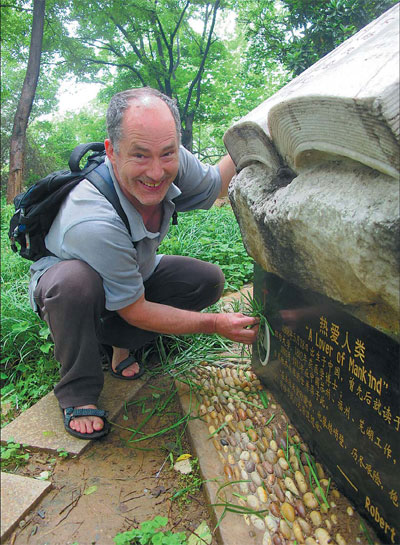Man on a mission By Wang Kaihao (China Daily)

Stanley Crawford cleans the memorial dedicated to his great-grandfather, Edgerton Hart, at Yijishan Hospital in Wuhu, Anhui province. Wang Kaihao / China Daily
My China Dream | Stanley Crawford
The great-great-grandson of an American Methodist missionary travels to China to retrace his ancestors’ footsteps. Wang Kaihao joins him in Anhui province.
Stanley Crawford isn’t a patient or a healthcare provider, but doctors and nurses at Yijishan Hospital of Wannan Medical College in Wuhu, Anhui province, nod and smile knowingly when they see him there.
The American quietly polishes a book-shaped stele in the hospital’s garden with a fistful of grass before suddenly shouting to passers-by: “This is my great-grandfather!”
Doctor Fu Yuelian smiles and greets him in simple English.
“I see him a few times a month although I don’t know his name,” she says.
Crawford has come to the hospital to retrace the steps of his great-great-grandfather, Virgil Hart, a Methodist missionary who arrived in China in 1866 and settled down in Jiujiang, Jiangxi province, a year later.
He embarked on an ambitious mission to build several hospitals and schools along the Yangtze River in the following decades.
He founded Yijishan Hospital in 1888. Crawford’s great-grandfather, Edgerton Hart, was born in Jiujiang in 1868 and became the hospital’s director in 1895.
Wuhu became a trading port after the Sino-British Yantai Treaty in 1876. It became a major hub for foreign missionaries.
“I know some foreigners did something bad in China at that time, like selling opium, but I am proud my ancestors were not among them,” Crawford says.
The little memorial in the hospital garden was built in 2000 to commemorate Edgerton Hart. Edgerton Hart’s tombstone is believed to have been destroyed during World War II, like many foreigners’ graves in the same cemetery.
Crawford worked as an English teacher in the Wuhu-based Wannan Medical College for a year and a half, after he took a position at the medical school of Jiujiang University in Jiangxi province for three years. He says he wanted to take a medical-related job to honor his great-great-grandfather.
“When I was a child, I was fascinated by a black-and-white photograph of the Summer Palace,” he says.
“And I was sure I would go to China one day.”
He didn’t begin to plan the specifics of his childhood dream until his grandmother Carolyn Hart had a long talk with him in 1998. She asked him to complete a mission for her in China.
She was born in Wuhu in 1908 and left in 1913, after Edgerton Hart died of typhus. Some members of the Hart family stayed in China until 1924.
Although Carolyn Hart returned to China twice in the early 1980s, she couldn’t go to Wuhu because overseas visitors were restricted at that time.
Crawford says that was the reason he was so excited when he landed in Wuhu in February 1999 and stepped through Yijishan Hospital’s gates.
He’s still emotional about the experience.
He almost bursts into tears when he enters the room his great-grandfather had used, although the floor is scattered with broken glass and wood splinters. The old wing is being renovated because the hospital needs new wards.
In 1999, Crawford took two months to travel to more than 20 cities. But he believed the time was too short.
He returned in 2003, bringing with him several books of missionaries’ stories, most of which were first published a century ago.
He wanted to retrace his great-great-grandfather’s footsteps, but many places were gone.
After five years of research and preparation, Crawford started writing his own quartet of books in 2009, tracing the history of the Hart missions all over China. He finished in May but is still looking for a publisher in China.
He has privately printed 500 copies and plans to bring some back to the United States as gifts.
“It’s for the whole Hart family, especially for my grandmother.”

Dr Virgil Hart (far left), his wife (far right) and their children.
Man on a mission
The only regret he has is that Carolyn Hart died in 2006 before she was able to see the books.
Zhou Dongdong, a 28-year-old IT manager with Wuhu.me, a social network for expatriates living in Wuhu, helped Crawford contact a local printer. Zhou didn’t know much about Yijishan Hospital’s history before he met Crawford in 2011.
“He couldn’t stop talking when we met,” Zhou says, explaining why he agreed to help Crawford.
“It’s interesting to see our own land through a foreigner’s eyes.”
Crawford says: “I’d like to tell Chinese people the history of their own cities because some of them may not know it. I only want to sell my books where my ancestors once worked, and I don’t expect them to be best-sellers.”
However, he says, if the books do sell well, he will establish a fund to help people living with disabilities in Wuhu.
Zhou is touched by all the old pictures the Hart family collected but also points out that there are still “misconceptions” in the records, which testify to cultural differences.
Li Yantian is the director of Wuhu Cultural Relics Association, and Crawford had contacted her to verify the exact location of the missionaries’ cemetery.
“I was surprised,” she says.
“There had been many missionaries in Wuhu, and many of their descendants visited. But none, to my knowledge, had studied their history so seriously.”
Li showed Crawford the location of the graveyard, which is now the hospital’s lawn.
She became interested in Crawford’s books and would like to learn more from him about the missionaries’ history. But time is running out for Crawford. He ends his nine-year project in July.
Crawford, a self-employed engineer, is well-traveled. But it’s in China that he has stayed the longest, visiting more than 100 cities.
“Many foreigners still consider China to be a mysterious land,” he says.
“But if we have an open mind and an open heart, it’s really no problem at all.”
